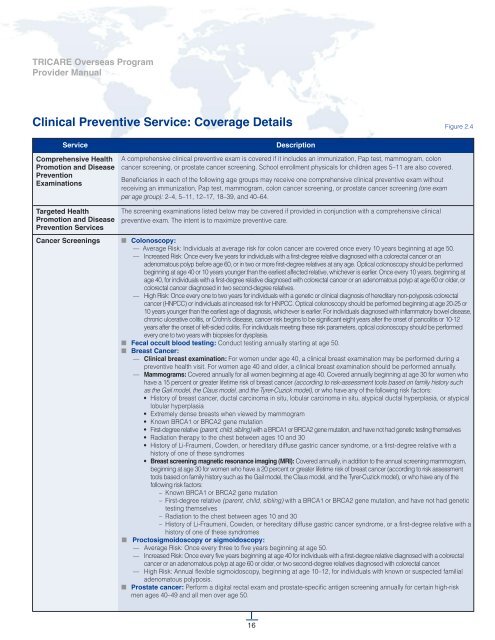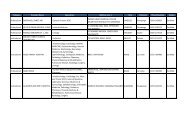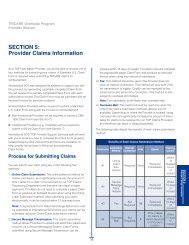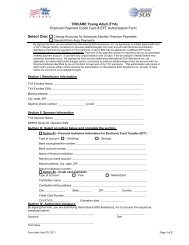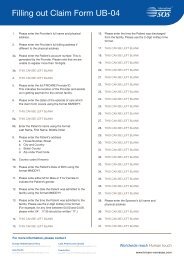TRICARE Overseas Program Provider Manual
TRICARE Overseas Program Provider Manual
TRICARE Overseas Program Provider Manual
You also want an ePaper? Increase the reach of your titles
YUMPU automatically turns print PDFs into web optimized ePapers that Google loves.
<strong>TRICARE</strong> overseas <strong>Program</strong><br />
<strong>Provider</strong> <strong>Manual</strong><br />
Clinical Preventive Service: Coverage Details Figure 2.4<br />
Service<br />
Comprehensive Health<br />
Promotion and Disease<br />
Prevention<br />
Examinations<br />
Targeted Health<br />
Promotion and Disease<br />
Prevention Services<br />
Cancer Screenings<br />
Description<br />
A comprehensive clinical preventive exam is covered if it includes an immunization, Pap test, mammogram, colon<br />
cancer screening, or prostate cancer screening. School enrollment physicals for children ages 5–11 are also covered.<br />
Beneficiaries in each of the following age groups may receive one comprehensive clinical preventive exam without<br />
receiving an immunization, Pap test, mammogram, colon cancer screening, or prostate cancer screening (one exam<br />
per age group): 2–4, 5–11, 12–17, 18–39, and 40–64.<br />
The screening examinations listed below may be covered if provided in conjunction with a comprehensive clinical<br />
preventive exam. The intent is to maximize preventive care.<br />
■ Colonoscopy:<br />
— Average Risk: Individuals at average risk for colon cancer are covered once every 10 years beginning at age 50.<br />
— Increased Risk: Once every five years for individuals with a first-degree relative diagnosed with a colorectal cancer or an<br />
adenomatous polyp before age 60, or in two or more first-degree relatives at any age. Optical colonoscopy should be performed<br />
beginning at age 40 or 10 years younger than the earliest affected relative, whichever is earlier. Once every 10 years, beginning at<br />
age 40, for individuals with a first-degree relative diagnosed with colorectal cancer or an adenomatous polyp at age 60 or older, or<br />
colorectal cancer diagnosed in two second-degree relatives.<br />
— High Risk: Once every one to two years for individuals with a genetic or clinical diagnosis of hereditary non-polyposis colorectal<br />
cancer (HNPCC) or individuals at increased risk for HNPCC. Optical colonoscopy should be performed beginning at age 20-25 or<br />
10 years younger than the earliest age of diagnosis, whichever is earlier. For individuals diagnosed with inflammatory bowel disease,<br />
chronic ulcerative colitis, or Crohn’s disease, cancer risk begins to be significant eight years after the onset of pancolitis or 10-12<br />
years after the onset of left-sided colitis. For individuals meeting these risk parameters, optical colonoscopy should be performed<br />
every one to two years with biopsies for dysplasia.<br />
■ Fecal occult blood testing: Conduct testing annually starting at age 50.<br />
■ Breast Cancer:<br />
— Clinical breast examination: For women under age 40, a clinical breast examination may be performed during a<br />
preventive health visit. For women age 40 and older, a clinical breast examination should be performed annually.<br />
— Mammograms: Covered annually for all women beginning at age 40. Covered annually beginning at age 30 for women who<br />
have a 15 percent or greater lifetime risk of breast cancer (according to risk-assessment tools based on family history such<br />
as the Gail model, the Claus model, and the Tyrer-Cuzick model), or who have any of the following risk factors:<br />
• History of breast cancer, ductal carcinoma in situ, lobular carcinoma in situ, atypical ductal hyperplasia, or atypical<br />
lobular hyperplasia<br />
• Extremely dense breasts when viewed by mammogram<br />
• Known BRCA1 or BRCA2 gene mutation<br />
• First-degree relative (parent, child, sibling) with a BRCA1 or BRCA2 gene mutation, and have not had genetic testing themselves<br />
• Radiation therapy to the chest between ages 10 and 30<br />
• History of Li-Fraumeni, Cowden, or hereditary diffuse gastric cancer syndrome, or a first-degree relative with a<br />
history of one of these syndromes<br />
• Breast screening magnetic resonance imaging (MRI): Covered annually, in addition to the annual screening mammogram,<br />
beginning at age 30 for women who have a 20 percent or greater lifetime risk of breast cancer (according to risk assessment<br />
tools based on family history such as the Gail model, the Claus model, and the Tyrer-Cuzick model), or who have any of the<br />
following risk factors:<br />
– Known BRCA1 or BRCA2 gene mutation<br />
– First-degree relative (parent, child, sibling) with a BRCA1 or BRCA2 gene mutation, and have not had genetic<br />
testing themselves<br />
– Radiation to the chest between ages 10 and 30<br />
– History of Li-Fraumeni, Cowden, or hereditary diffuse gastric cancer syndrome, or a first-degree relative with a<br />
history of one of these syndromes<br />
■<br />
Proctosigmoidoscopy or sigmoidoscopy:<br />
— Average Risk: Once every three to five years beginning at age 50.<br />
— Increased Risk: Once every five years beginning at age 40 for individuals with a first-degree relative diagnosed with a colorectal<br />
cancer or an adenomatous polyp at age 60 or older, or two second-degree relatives diagnosed with colorectal cancer.<br />
— High Risk: Annual flexible sigmoidoscopy, beginning at age 10–12, for individuals with known or suspected familial<br />
adenomatous polyposis.<br />
■ Prostate cancer: Perform a digital rectal exam and prostate-specific antigen screening annually for certain high-risk<br />
men ages 40–49 and all men over age 50.<br />
16


